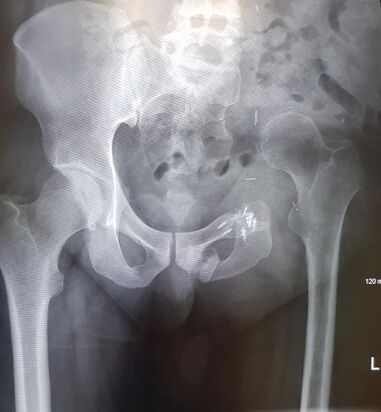Medicine:Hemipelvectomy
| Hemipelvectomy | |
|---|---|
 Intraoperative photograph after hemipelvectomy on the right side with view of the acetabulum. This was done for a case of gas gangrene. | |
| Other names | Hindquarter amputation, pelvic resection |
| Specialty | Orthopedic surgery |
Hemipelvectomy, also known as a pelvic resection, is a surgical procedure that involves the removal of part of the pelvic girdle. This procedure is most commonly performed to treat oncologic conditions of the pelvis.[1][2] Hemipelvectomy can be further classified as internal and external hemipelvectomy.[1][2] An internal hemipelvectomy is a limb-sparing procedure where the innominate bone is resected while preserving the ipsilateral limb.[1][2] An external hemipelvectomy involves the resection of the innominate bone plus amputation of the ipsilateral limb.[1][2]
Medical uses
Hemipelvectomy is generally reserved for the treatment of pelvic neoplasms.[1][2] Examples of malignancies that are treated with hemipelvectomy include osteosarcoma, chondrosarcoma, and Ewing's sarcoma.[1] Rarely, hemipelvectomy is performed in settings of traumatic injury and osteomyelitis.[1] Indications for external hemipelvectomy include neoplastic extension into the sciatic nerve, where loss of function of the lower extremity is anticipated.[1] Internal hemipelvectomy is preferred when complete resection of the tumor is possible without sacrificing the lower extremity.[1] If external hemipelvectomy cannot provide a greater degree of tumor resection compared to internal hemipelvectomy, internal hemipelvectomy is recommended.[1] Internal hemipelvectomy must only be considered when the surgical approach can ensure the preservation of critical neurovascular structures in the region.[1]
Complications
As with any surgical procedure, risks include infection, blood loss, damage to surrounding structures, cardiac/pulmonary complications, and adverse reactions to anesthesia.
Complications of external hemipelvectomy include:[1][2]
- Disfigurement
- Loss of ambulation
- Phantom limb pain
- Bladder dysfunction
- Sexual dysfunction
- Bowel dysfunction
Complications of internal hemipelvectomy include:[1][2]
- Leg-length discrepancy
- 'Flail hip' or 'floating hip' (referring to hypermobility of the hip joint)
- Hip instability
Technique
Prior to performing a hemipelvectomy, surgeons must possess detailed knowledge of the pelvic anatomy and its relation to the pelvic tumor.[1] Imaging studies such as conventional radiography, computed tomography, and magnetic resonance imaging help the surgeon visualize the anatomy and its relationship to the local pathology.[1] Surgical oncology techniques are utilized when resecting tumors of the pelvis.[1] Such techniques ensure that adequate resection margins are obtained at the time of surgery to minimize tumor recurrence.[1]
The Enneking and Dunham classification system was developed in 1978 to aid surgeons in characterizing pelvic resections.[1][3][4] This classification scheme breaks down pelvic resections into 3 subtypes: Type I, Type II, and Type III.[1][3][4] Type I resections involve removal of the ilium.[1][3][4] Type II resections involve removal of the peri-acetabular region.[1][3][4] Type III resections involve removal of the ischial and/or pubic region.[1][3]
Resection of pelvic bone typically requires subsequent reconstruction to ensure stability of the hip joint, particularly in internal hemipelvectomy.[1] Examples of pelvic reconstruction include the use of an allograft, autograft, or prosthesis to bridge the remaining ends of pelvic bone following resection.[1][4] Arthrodesis is a technique that can be used in internal hemipelvectomy to fix the proximal femur to a segment of pelvic bone for the purposes of stabilizing the lower extremity.[1][4]
Additional images
References
- ↑ Jump up to: 1.00 1.01 1.02 1.03 1.04 1.05 1.06 1.07 1.08 1.09 1.10 1.11 1.12 1.13 1.14 1.15 1.16 1.17 1.18 1.19 1.20 1.21 1.22 1.23 1.24 Wedemeyer, Christian; Kauther, Max Daniel (2011-03-16). "Hemipelvectomy- only a salvage therapy?". Orthopedic Reviews 3 (1): e4. doi:10.4081/or.2011.e4. ISSN 2035-8237. PMID 21808716.
- ↑ Jump up to: 2.0 2.1 2.2 2.3 2.4 2.5 2.6 "Cedars-Sinai". https://www.cedars-sinai.edu/Patients/Programs-and-Services/Imaging-Center/For-Physicians/Musculoskeletal-Radiology/Exhibits-and-Presentations/Limb-Sparing-Saddle-Prosthesis-and-Pelvic-Neoplasia/Surgical-Options-Hemipelvectomy.aspx.
- ↑ Jump up to: 3.0 3.1 3.2 3.3 3.4 "Cedars-Sinai". https://www.cedars-sinai.edu/Patients/Programs-and-Services/Imaging-Center/For-Physicians/Musculoskeletal-Radiology/Exhibits-and-Presentations/Limb-Sparing-Saddle-Prosthesis-and-Pelvic-Neoplasia/Classification-of-Pelvic-Resections.aspx#:~:text=In%201978,%20Enneking%20and%20Dunham,Resection%20confined%20to%20the%20pubis..
- ↑ Jump up to: 4.0 4.1 4.2 4.3 4.4 4.5 Ji, Tao; Guo, Wei (2019-06-19). "The evolution of pelvic endoprosthetic reconstruction after tumor resection" (in en). Annals of Joint 4: 29. doi:10.21037/aoj.2019.06.01. http://aoj.amegroups.com/article/view/5176.
External links
 |



